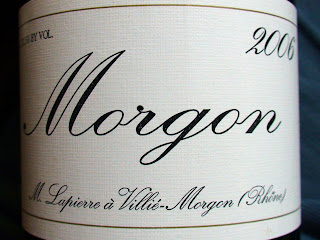By the Glass - Purity Edition
This is not a post about wines that are chaste. This has nothing to do with the new Republican Vice Presidential nominee. This is a post about "purity," a common wine descriptor that I've been thinking about lately.
I often see "purity" in tasting notes as a way of describing wine. Certain wines are very pure, and appreciating this can be a big part of the pleasure that a wine gives. Appreciating purity in wine is interesting because it really means appreciating what is not present in a wine.
What does it mean to say that a wine has "great purity?" Purity refers to the lack of anything that might obscure a wine's natural aromas and flavors. New oak, added sugar, acids, or enzymes, industrial yeasts, pesticides and other sprays, excessively late hang times - these things, among others, can add their own layers of aroma, texture, and flavor to wine.
I'm not saying that it's impossible to make a wine of purity if new wood is used. And I'm not saying wines that are fermented using industrial yeasts are never pure. Purity is something that cannot be defined so absolutely, like oak or malolactic, for example. New oak is either used or it's not. Wine either goes through malolactic fermentation or it doesn't. Purity might be more akin to beauty - it's in the eye of the beholder.
To me, a wine doesn't taste pure, it feels pure. I get it when I can sense how clean the fruit is, when I can feel the clarity and definition of its aromas. When it breaks down on my tongue to reveal something more than just fruit, something essential about the grape variety, and about the soil and the place where it was cultivated. Hard to define, I guess, but for me, easier to feel.
Here are some wines I've had recently that I found to be of exceptional purity. These may or may not be available on retail shelves in your area. If not, no matter - these are producers who make wines of exceptional purity every year. It's part of their style. Is it a coincidence that these producers tend to farm biodynamically? You decide. 2005 Domaine Weinbach Sylvaner Clos des Capuchins Réserve, price unknown but about $20, Vineyard Brands Imports. As can be expected of an Alsace wine made using Sylvaner, this wine is very mineral. The nose offers clean metallic notes, and there are focused citrus and mineral flavors. It really blossoms on day two when melon and floral aromas emerge at the front of the nose, which is still dominated by clean and pure minerals. This is a very pretty wine, one that would work well with shellfish on day one or with a plate of ham, bread and good butter on day two.
2005 Domaine Weinbach Sylvaner Clos des Capuchins Réserve, price unknown but about $20, Vineyard Brands Imports. As can be expected of an Alsace wine made using Sylvaner, this wine is very mineral. The nose offers clean metallic notes, and there are focused citrus and mineral flavors. It really blossoms on day two when melon and floral aromas emerge at the front of the nose, which is still dominated by clean and pure minerals. This is a very pretty wine, one that would work well with shellfish on day one or with a plate of ham, bread and good butter on day two.
2006 Marcel Lapierre Morgon, $23, Kermit Lynch Imports. A Beaujolais that drinks much
2006 Gilles Azzoni Vin de Pays de l'Ardèche Le Raisin et L'Ange Fable. $15, Jenny & Francois Selections. Not your typical Syrah, that's for sure. This is high elevation light bodied fresh and pure wine, almost shrill with acidity. But the aromas of young Syrah fruit - bacon fat, horses, purple flowers, herbs and earth - they are all readily apparent. Tough by itself, this wine shines with dinner. Late summer tomatoes, grilled pork, duck...this will stand up to and compliment these and other dishes.







4 comments:
Love this topic! For some reason I've also been thinking about how to describe various wine terms: purity, linear. Even terms like 'floral' and 'mineral' and 'earthy' can be confusing to both wine newcomers and those looking to move beyond wines are 'fruity, oaky, buttery'. I face this every day in the store, trying to describe a wine in a way that's understandable without being either too dumbed down or too esoteric.
Please keep up this thread - it's great food for thought.
-Christy
www.franklywines.blogspot.com
I love that Lapierre. Biodynamic too I think, doesn't get much more pure than that!
Neil - too funny, I almost brought you the Lapierre instead of the Aligote. Maybe you'll get lucky another day. The Weinbach Riesling Cuvee Ste-Catherine was one of the best whites I have ever tasted, but Sylvaner? That I have to try.
Interesting comments on the 2004 Amiot. I’ve been pleasantly surprised by some of the 2004s red Burgundies that I have tasted recently too. I think those who were able to wait, harvest later and do enough triage to get only healthy fruit made some very good wines.
Post a Comment